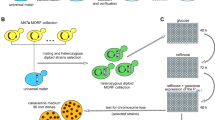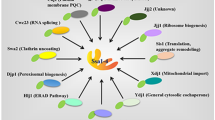Abstract
Three G1 cyclins,CLN1,CLN2, andCLN3, have been identified in the budding yeastSaccharomyces cerevisiae. G1 cyclins are essential, albeit functionally redundant, rate-limiting activators of cell cycle initiation. We have isolated dosage-dependent suppressor genes (designatedHMD genes) of the mating defect caused byCLN3-2, a dominant mutation inCLN3,HMD2 andHMD3 are identical toSTE4 andSTE5, respectively,HMD1 is an essential gene that encodes a protein containing a putative RNA binding domain. Overproduction ofHMD1 results in a relatively specific reduction in the level of theCLN3 orCLN3-2 transcript. This reduction occurs subsequent to transcription initiation ofCLN3 since overexpression ofHMD1 did not affect expression of a heterologous transcript from theCLN3 promoter but did result in a reduction ofCLN3 transcript expressed from a heterologous promoter.HMD1 has at least one essential role independent of its effect onCLN3 sinceHMD1 remains essential for viability in the absence of a functionalCLN3 gene.
Similar content being viewed by others
References
Cross F (1988)DAF1, a mutant gene affecting size control, pheromone arrest, and cell cycle kinetics ofSaccharomyces cerevisiae. Mol Cell Biol 8:4675–4684
Doi K, Gartner A, Ammerer G, Errede B, Shinkawa H, Sugimoto K, Matsumoto K (1994) MSG5, a novel protein phosphatase promotes adaptation to pheromone response inS. cerevisiae. EMBO J 13:61–70
Dreyfuss G, Swanson MS, Pinol-Roma S (1988) Heterogeneous ribonucleoprotein particles and the pathway of mRNA formation. Trends Biochem Sci 13:86–91
Gietz RD, Sugino A (1988) New yeast-Eschericia coli shuttle vectors constructed with in vitro mutagenized yeast genes lacking sixbase pair restriction sites. Gene 74:527–534
Ito H, Fukuda Y, Murata K, Kimura A (1983) Transformation of intact yeast cells treated with alkali cations. J Bacteriol 153:163–168
Kenan DJ, Query CC, Keene JD (1991) RNA recognition: towards identifying determinants of specificity. Trends Biochem Sci 16:214–220
Kim Y-J, Baker BS (1993) Isolation of RRM-type RNA-binding protein genes and the analysis of their relatedness by using a numerical approach. Mol Cell Biol 13:174–183
Mukai Y, Harashima S, Oshima Y (1993) Function of the Ste signal transduction pathway for mating pheromone sustainsMATa1 transcription inSaccharomyces cerevisiae. Mol Cell Biol 13:2050–2060
Nash R, Tokiwa G, Anand S, Erickson E, Futcher AB (1988) TheWHI1 + gene ofSaccharomyces cerevisiae tethers cell division to cell size and is a cyclin homolog. EMBO J 7:4335–4346
Pine J (1993) Cyclins and cyclin-dependent kinases: take your partners. Trends Biochem Sci 18:195–197
Pringle JR, Hartwell LH (1981) TheSaccharomyces cerevisiae cell cycle. In: Strathern J, Jones EW, Broach JR (eds) The molecular biology of the yeastSaccharomyces cerevisiae. Cold Spring Harbor Laboratory, Cold Spring Harbor, N.Y., pp 97–142
Reid BJ, Hartwell LH (1977) Regulation of mating in the cell cycle ofSaccharomyces cerevisiae. J Cell Biol 75:355–365
Richardson HE, Wittenberg C, Cross F, Reed SI (1989) An essential GI function for cyclin-like proteins in yeast. Cell 59:1127–1133
Rose MD, Broach JR (1991) Cloning genes by complementation in yeast. Methods Enzymol 194:195–230
Rothstein R (1983) One step gene disruption in yeast. Methods Enzymol 101:202–211
Sambrook J, Fritsch EF, Maniatis T (1989) Molecular cloning: a laboratory manual, 2nd edn., Cold Spring Harbor Laboratory, Cold Spring Harbor, New York
Sherman F, Fink GR, Hicks JB (1986) Laboratory course manual for methods in yeast genetics. Cold Spring Harbor Laboratory, Cold Spring Harbor, New York
Tyers M, Tokiwa G, Nash R, Futcher B (1992) The Cln3-Cdc28 kinase complex ofSaccharomyces cerevisiae is regulated by proteolysis and phosphorylation. EMBO J 11:1773–1784
Valdivieso MH, Sugimoto K, Jahng K-Y, Fernandes PMB, Wittenberg C (1993)FAR1 is required for posttranscriptional regulation ofCLN2 gene expression in response to mating pheromone. Mol Cell Biol 12:1013–1022
Whiteway MS, Hougan L, Dignard D, Thomas DY, Bell L, Saari GC, Grant FJ, O'hara P, Mackay VL (1989) TheSTE4 andSTE18 genes of yeast encode potentialβ and γ subunits of the mating factor receptor-coupled G protein. Cell 56:467–477
Wilson SM, Datar KV, Paddy MR, Swedlow JR, Swanson MS (1994) Characterization of nuclear polyadenylated RNA-binding proteins inSaccharomyces cerevisiae. J Cell Biol 127:1173–1184
Wittenberg C, Sugimoto K, Reed SI (1990) G1-specific cyclins ofSaccharomyces cerevisiae: cell cycle periodicity, regulation by mating pheromone and association with the p34cdc28 protein kinase. Cell 62:225–237
Author information
Authors and Affiliations
Additional information
Communicated by M. Sekiguchi
Rights and permissions
About this article
Cite this article
Sugimoto, K., Matsumoto, K., Kornberg, R.D. et al. Dosage suppressors of the dominant G1 cyclin mutantCLN3-2: Identification of a yeast gene encoding a putative RNA/ssDNA binding protein. Molec. Gen. Genet. 248, 712–718 (1995). https://doi.org/10.1007/BF02191711
Received:
Accepted:
Issue Date:
DOI: https://doi.org/10.1007/BF02191711




